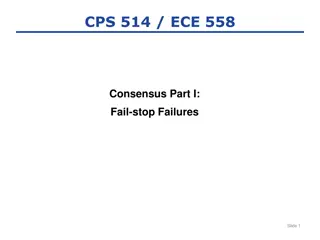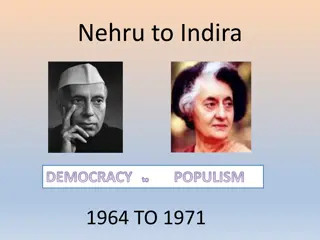Jawaharlal Nehru: Visionary Leader and Architect of Modern India
Jawaharlal Nehru, a prominent leader of India's nationalist movement, played a crucial role in shaping the country's policies post-independence. As India's first Prime Minister, he focused on pillars like democracy, socialism, secularism, and nationalist unity. Nehru's domestic policies emphasized secularism, social reform, education, and economic redistribution. He introduced economic reforms, industrial policies focusing on harnessing natural resources, and a foreign policy supporting independence movements worldwide.
Download Presentation

Please find below an Image/Link to download the presentation.
The content on the website is provided AS IS for your information and personal use only. It may not be sold, licensed, or shared on other websites without obtaining consent from the author. Download presentation by click this link. If you encounter any issues during the download, it is possible that the publisher has removed the file from their server.
E N D
Presentation Transcript
Understanding Jawaharlal Nehru(1889 1964) and his policies
Jawaharlal Nehru, was a leader of Indias nationalist movement and became India s first prime minister after its independence. In 1919, he joined Congress and joined Movements. He was to serve a total of nine sentences, adding up to more than nine years in jail. Became first Prime Minister of Independent India. Nehru's four pillars of domestic policies were democracy, socialism, secularism the Indian Indian National Nationalist unity, and
Domestic Policy 1. He secularism, insisted upon the basic unity of India. 2. In the face of ethnic and religious diversity, he carried India into the modern age of scientific innovation and technological progress. 3. He prompted social concern for the marginalized and poor and respect for democratic values. 4. Nehru reform the antiquated Hindu civil code. 5. Hindu widows could enjoy equality with men in matters of inheritance and property. 6. Nehru changed Hindu discrimination. 7. Established many Indian institutions of higher learning, including the All India Institute the Indian Institutes of Technology, Institutes of Technology, 8. Guaranteed free and compulsory primary education to all of India's children. imparted modern values and thought, stressed law to criminalize caste of Medical and Sciences, National the
Economic Reforms of Nehru 1. Firm believer in state control over the economic sectors. 2. His socialist ideals revealed themselves in the way he introduced laws for land redistribution, in order to curtail the economic disparity in India among the landed and the land-less classes. 3. His Economic policy considered to be Socialist in nature. 4. Key economic reforms was the introduction of the Five Years Plan in 1951. It was introduce to government expenditure and grants in important development sectors like agriculture, industries and education. determine the mode of
Nehru's Industrial Policies: Nehru was intent to harness and fully exploit the natural resources of India for the benefit of his countrymen. The main sector he identified was hydroelectricity. He constructed a number of dams to achieve that end. The dams would not only harness energy, but would also support irrigation to a great degree. Nehru considered dams to be the very symbol of India's collective growth, as they were the platforms where industrial engineering and agriculture met on a common platform.
Nehru's Foreign Policy Jawaharlal imperialist policy. He extended his support for the independence of small and colonized nations of the world. One of the prominent architects of the Non-Aligment Movement (NAM) NAM was formed during the Cold War, largely on the initiative of then-Yugoslav President Josip Broz Tito The basic concept for the group originated in 1955 during discussions that took place at the Asia-Africa Bandung Conference held in Indonesia. NAM has sought to "create an independent path in world politics that would not result in member States becoming pawns in the struggles between the major powers." Man behind the design of India s Foreign Policy Nehru was supporter of the anti-
Panchsheel , or the Five Principles of Peaceful Co-existence, were first formally enunciated in the Agreement on Trade between the Tibet region of China and India signed on April 29,1954, Agreement based on the following principles: - and Intercourse 1. Mutual respect for each other s territorial integrity and sovereignty, 2. Mutual non-aggression 3. Mutual non-interference, 4. Equality and mutual benefit, and 5. Peaceful co-existence.
Sino-Indian War of 1962 Roots of the Sino-Indian conflict in 1962 1. The Indian Government had granted asylum to Dalai Lama after his banishment uprising in 1959 and it irked China. 2. Boundary disputes over Arunachal Pradesh and Aksai Chin area in Ladakh, on the 3,225-kilometre-long disputed border issue. 3. Nehru and his Chinese counterpart, Premiere Zhou Enlai were unable to reach a political accord. 4. They captured Rezang la in Chushul and Tawang in Arunachal Pradesh- started on October 20- ended November 20, 1962 following the Tibet the MacMohan Line in























